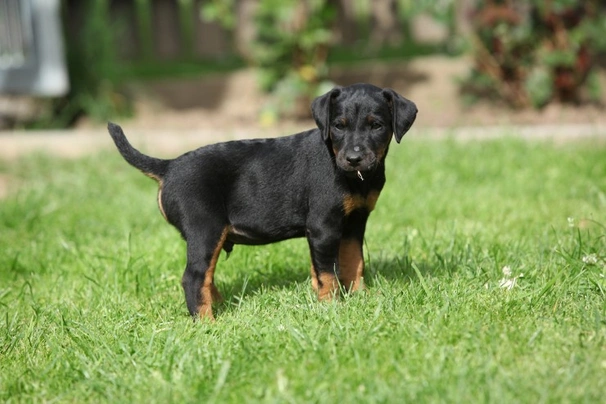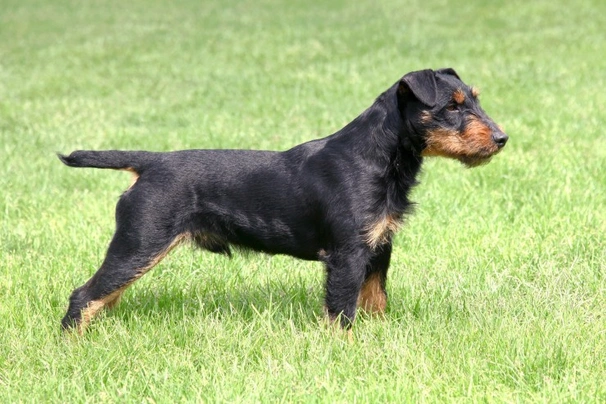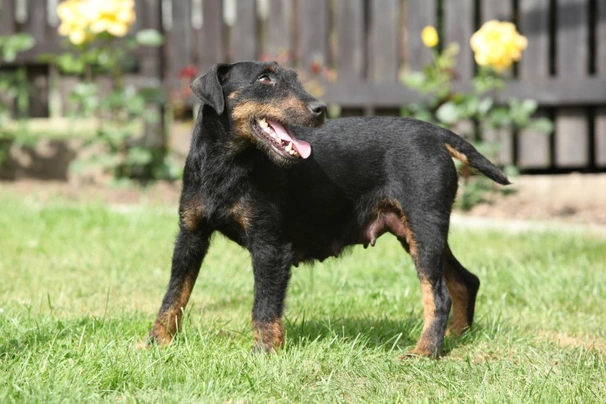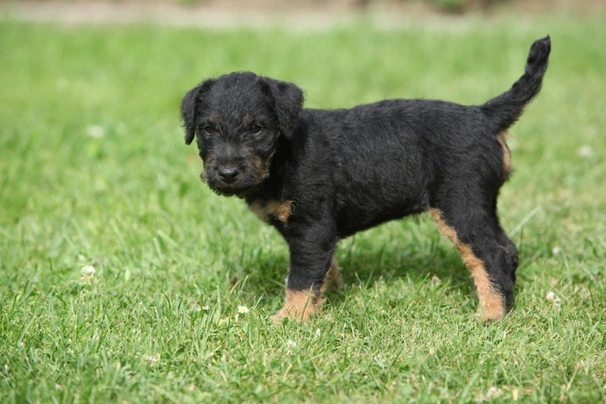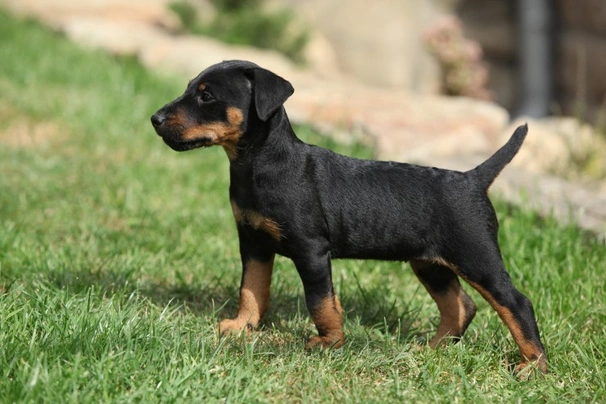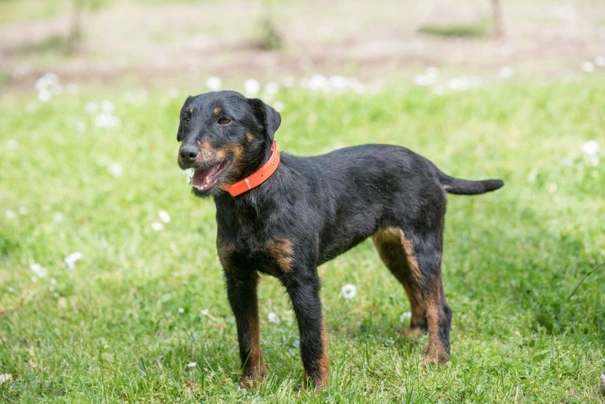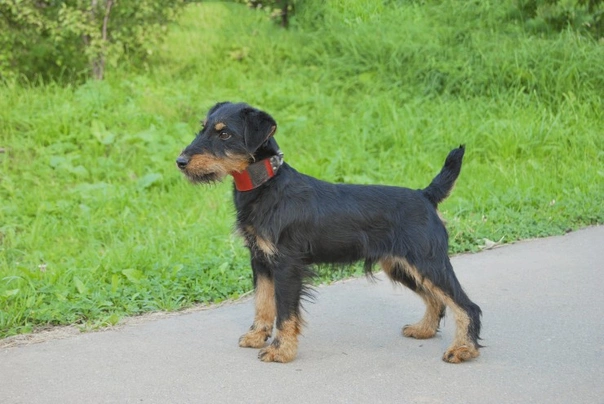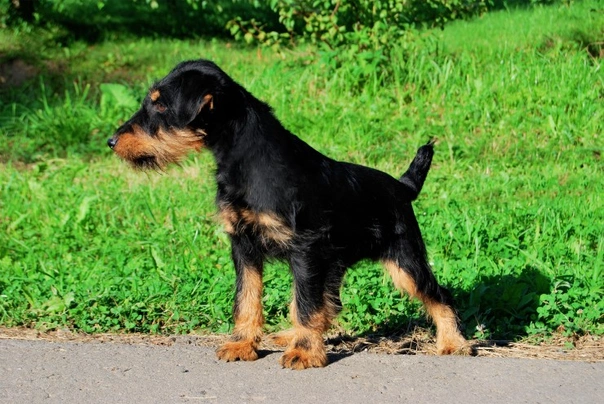Jagdterrier
Pros
Cons
Introduction of the Jagdterrier
Jagdterriers are small dogs that originate from Germany where they were originally bred to work both above and below ground tracking their prey. They have always been highly prized for their hunting abilities in their native land and Europe in general where Jagdterriers are still used to hunt larger game like wild boar and smaller quarry like badgers foxes and weasels.
Although lesser known here in the UK the Jagdterrier is a smart looking little dog and one that's highly intelligent with the added bonus being they form strong bonds with their families and owners which in short means they are not only very good working dogs but they make great companions and family pets too. With this said the breed is not Kennel Club recognised and very few well-bred puppies are available every year which means that anyone wanting to share a home with a Jagdterrier would need to register their interest with breeders for the pleasure of doing so.
History of the Jagdterrier
Jagdterriers were developed to be hunting dogs in their native Germany where they have always been highly prized for their skills at tracking down small and larger prey. The goal of breeders and genetic enthusiasts alike was to create the perfect German working terrier that would not only be rated as being as good as American and British breeds but even better.
Terriers were hugely popular throughout Europe in the early 1900's. They were also immensely popular in the United States. The largest dog show in the world was to be established in the UK at the end of the World War I which was to become known as Crufts although at first it was called the Allied Terrier Show. At the time there was also a publication that was founded dedicated to dogs and more especially to Fox Terriers.
It was a time when "show" dogs rather than working-types became hugely popular. As such many working qualities of terriers were lost and this included their scenting skills as well as their endurance stamina keenness and determination along with their acute hearing and keen vision. Many Fox Terrier breeders and enthusiasts were not keen on seeing so many changes in working terrier lines and set up what was to become known as the German Fox Terrier Association with the end goal being to retain the hunting abilities and traits of terriers.
At the end of the First World War the members of the German Fox Terrier Association broke with the club to set up their own project which was to develop the "perfect" German terrier. One of the members a man called Zangenberg was given or purchased black Fox Terrier puppies that were sire by an English Terrier. There were 2 females and 2 males in the litter which were all wire-haired puppies with black coats and red markings. These puppies were to become the foundation dogs for the Jagdterrier and their names were Werwolf Raughgraf Morla and Nigra von Zangenberg.
A man called Lutz Heck who was the curator at the Berlin Zoo and a keen hunter who also boasted an ardent interest in genetics joined the other members of the project to further their endeavours to develop the "perfect" terrier. Another man who helped develop the breed was Dr. Herbert Lackner and as many as 700 dogs were used in the breeding programme. No dogs were allowed to leave the kennels the whole time the breed was being developed and any terrier that did not meet their standards were disposed of.
It is thought that the foundation breeds used to create and develop the Jagdterrier could have been Fox Terriers but it could have also been black and tan Fell Terriers and Welsh Terriers as well as Old English Terriers. In 1926 the German Hunting Terrier Club was established with the breed being first introduced onto the scene a year later in 1927. Jagdterriers were an immediate success not only with the German hunting fraternity but also with the military.
At the end of the Second World War breed numbers had been decimated throughout Germany but enthusiasts worked hard to save the Jagdterrier from disappearing off the face of the planet altogether. They outcrossed their remaining terriers with Lakeland Terriers but this proved to be unsuccessful and the breeding programme was subsequently abandoned.
By the beginning of the 1950's breed numbers however began to rise without the need to outcross to other breeds. Over the years the breed's popularity began to rise again in the native Germany as it did elsewhere in Europe because over time they earned themselves a reputation for being excellent working dogs and companions both in American where they are used as “tree dogs” to track down squirrels and raccoons. Although their numbers are still very low here in the UK the Jagdterrier is gaining popularity although anyone wishing to share their home with one would need to register their interest with breeders because so few puppies are bred every year.
The breed is not recognised by The Kennel Club but Jagdterriers are recognised by other international organisations which includes the American Kennel Club and the UKC as well as a few other international breed clubs. As previously mentioned Jagdterriers are seldom seen in the UK and anyone wanting to share a home with one would need to register their interest with breeders and go on a waiting list with the good news being the wait would be well worth it.
Interesting facts about the breed
- Is the Jagdterrier a vulnerable breed? No although they are quite rare in the UK and although they are gaining a big fanbase anyone wanting to share a home with a Jagdterrier would need to register their interest with breeders and go on a waiting list for the pleasure of doing so
- They are often called German Hunt Terriers in other parts of the world
- Breed numbers fell dangerously low at the end of World War II
- Jagdterriers are known to be one of the most tenacious terriers around
- Traditionally a Jagdterrier's tail was always docked but since the law banning the procedure came into effect in 2007 tail docking is now illegal with the exception being for some working breeds and if a dog suffers from some sort of health issue that requires their tails to be docked. The procedure must be agreed and authorised before being performed by a qualified vet
Appearance of the Jagdterrier
Height at the withers: Males 33 - 40 cm Females 33 - 40 cm
Average weight: Males 9 - 10 kg Females 7.5 - 8.5 kg
Jagdterriers are compact sturdy little dogs that boast having an alert appearance. When working they are athletic energetic and quick off the mark but when they are at rest they are regal looking although they always have a fiery expression in their eyes. Their heads are quite long being wedge-shaped with the area between a dog's ears being flat but tapering towards their eyes. They have a slight stop and shortish muzzles with nice prominent cheeks and extremely strong underjaws.
The Jagdterrier has a strong jaw with a perfect scissor bite where their upper teeth neatly overlap their lower ones and they have strong teeth. Their eyes are dark in colour and small being deeply set with dogs always having an alert determined look about them. Their noses are black although dogs with more brown in their coats can have brown noses which is acceptable. Their ears are V-shaped and nicely in proportion to a dog's head being set quite high and carried forwards touching the side of the head.
Jagdterriers have strong slightly arched powerful necks that are a little broader at the shoulder than at the nape. Shoulders are sloping and long with dogs having well-muscled front legs that show a good amount of bone. They have deep chests that are not too broad and their ribs are well sprung and nicely laid back. Their bodies are sturdy and compact with dogs having short level backs and well-muscled loins with flat croups.
Their hindquarters are well angulated and muscular showing a good amount of bone with dogs having long sinewy and powerful back legs. Feet are oval shaped with a dog's front ones often being wider and larger than their back feet. Tails are well set which dogs carry gaily much like the Foxhound when they are working or alert.
When it comes to their coat the Jagdterrier can either have a harsh or smooth coat as well as any kind of texture in between the two. However their coats are thick and dense which offers terriers a lot of protection when working in rough undergrowth and in challenging conditions. The accepted breed colour under AKC rules is as follows:
- Black with brown red yellow or lighter markings on eyebrows chest legs and back-ends
- Black and grey with brown red yellow or lighter markings on eyebrows chest legs and back-ends
- Dark brown with brown red yellow or lighter markings on eyebrows chest legs and back-ends
- Greyish black with brown red yellow or lighter markings on eyebrows chest legs and back-ends
Jagdterriers can have either a light or dark mask and a small amount of white both on their toes and chests is acceptable under the UKC's breed standard
Gait/movement
When a Jagdterrier moves they do so with great purpose speed and agility covering a log of ground when they do.
Faults
Prospective Jagdterrier owners should be wary of any puppies or dogs that show any sort of exaggeration whether in their looks or conformation and that extra-small dogs often come with many health issues so they are best avoided. A responsible breeder would always ensure that puppies they produce are of a good size and conformation and would avoid breeding extra small dogs for these reasons. Males should have both testicles fully descended into their scrotums.
Temperament of the Jagdterrier
The Jagdterrier has always been highly prized for their intelligence and hunting abilities because they are such determined little dogs. In short they are quick off the mark and will not give up until they achieve their goals all of which are traits that are deeply embedded in a dog's psyche even when they are in a home environment. They have a tremendous amount of stamina and energy which means they are best suited to people who live in a more rural environment and who lead active outdoor lives.
They are bold courageous and always extremely alert but very people oriented. They make good companions and family pets but they are first and foremost working dogs. As such they are not the best choice for first time owners but a good choice for anyone who is familiar with the breed or this type of high energy working dog and who therefore understands and can satisfy their specific needs.
They have extremely high prey drives and are never happier than when they are outside doing what they have always been bred to do which is to track and hunt down their quarry both above and below ground. Puppies need to be well socialised from a young age and this must involve introducing them to lots of new situations noises people other animals and dogs once they have been fully vaccinated so they mature into well-balanced calm adult dogs.
Their training must start early paying particular attention to the "recall" command right from the word go and even then if a Jagdterrier sees something in the distance they are likely to take off after it which is why care must be taken as to where and when they are allowed to run off their leads. They tend to be wary around people they don't know but rarely would a Jagdterrier show any sort of aggressive behaviour towards a stranger preferring to keep their distance until they get to know someone.
Are they a good choice for first time owners?
Jagdterriers are not a good choice for first time dog owners because they need to be socialised handled and trained by people who are familiar with the specific needs of an intelligent high-energy terrier with a low boredom threshold.
What about prey drive?
Having been bred to "work and hunt" a Jagdterrier has a very high prey drive and being so tenacious they never give up. As such great care must always be taken when they are around smaller animals and pets. Care should also be taken as to where and when a Jagdterrier can run off the lead especially if there is wildlife or livestock close by bearing in mind that if a terrier picks up a scent they are likely to ignore the recall command and go off in search of what is at the end of it.
What about playfulness?
Jagdterriers have a very playful side to their natures. They are fun-loving and high-energy all rolled into one small package. They love to be entertained and to entertain which they do through their working abilities. They are known to be a little mischievous when the mood takes them and being so clever a Jagdterrier quickly learns how to get their own way when they want something.
What about adaptability?
Jagdterriers may be small in stature but they are high-energy characters that are better suited to living with people who lead active outdoor lives rather than being cooped up in an apartment. They were bred to work which is something that is deeply embedded in a terrier's psyche and if they are not put through their paces they are very unhappy dogs.
What about separation anxiety?
Although Jagdterriers form strong ties with their families they do not generally suffer from separation anxiety providing they are not left to their own devices for too long. If they do find themselves on their own for too long a Jagdterrier would quickly find ways of amusing themselves bearing in mind that they have a very low boredom threshold. This could see them being destructive around the home and barking incessantly to get someone's attention and to show how unhappy they are at the situation.
What about excessive barking?
A lot of Jagdterriers like the sound of their own voices a little too much which is something that needs to be gently nipped in the bud when a dog is still young being careful not to frighten them. Others will only bark when there are strangers about or when something they don't like is going on in their surroundings or when they have chased something to "ground".
Do Jagdterriers like water?
Most Jagdterriers love swimming and will take to the water whenever they can more especially when the weather is hot. However if anyone who owns a dog that does not like water should never force them to go in because it would just end up scaring them. With this said care should always be taken when walking a Jagdterrier off the lead anywhere near more dangerous watercourses just in case a dog decides to leap in and then needs rescuing because they cannot get out of the water on their own.
Are Jagdterriers good watchdogs?
Jagdterriers are natural watchdogs because they are always on the alert. With this said rarely would a dog show any sort of aggressive behaviour preferring to keep their distance and bark as a way of alerting an owner to something they don't like that's going on.
Intelligence / Trainability of the Jagdterrier
The Jagdterrier is a highly intelligent little dog but they are also strong willed and independent by nature which can make training them a bit of a challenge. This is one of the reasons why they are not the best choice for novice owners who may find these quick-witted dogs a bit of handful especially as they are known to be dominant characters. Their training must start early in a dog's life and it must be consistent throughout their lives remembering that these terriers boast an extremely high prey drive.
They are bold courageous and hard which are traits needed in a hunting environment and it’s important to bear in mind that these traits remain deeply embedded in a dog's psyche which should be taken into account during their training. They need to be handled and trained with a very firm yet gentle hand and their training always must be fair so that dogs understand what is expected of them. Jagdterriers must be taught their place in the "pack" and who they can look to for direction and guidance for them to be obedient well-rounded dogs.
The key to successfully training a Jagdterrier is to keep their training sessions as interesting and as diverse as possible and to keep them short which is the best way to keep one of these quick-witted terriers focused on what is being asked of them. They would quickly lose interest in longer more repetitive training sessions because they would get bored.
Like all puppies Jagdterrier puppies are amazingly cute and it is all too easy to spoil them when they first arrive in their new homes. However they are also incredibly smart and quick to learn new things which includes the good and the bad. Owners need to start out as they mean to go which means that as soon as a puppy is settled they need to be taught the rules and boundaries of what is acceptable behaviour and what is not. It also helps establish a pecking order and who is the alpha dog in a household. The first commands a puppy should be taught are as follows:
- Come
- Sit
- Stay
- Heel
- Quiet
- Leave it
- Down
- Bed
Children and other
Jagdterriers might be lively and always alert but they can be calm and gentle around children. They might not be the best choice for families where the children are younger but they are a good choice for households where the kids are slightly older and who therefore know how to act around dogs. With this said any interaction between younger children and a dog should always be well supervised to make sure playtime does not get too boisterous which could end up with a child being knocked over and frightened or hurt.
When well socialised from a young enough age the Jagdterrier generally gets on well with other dogs but they can be a little "off" with dogs when they first meet them. If they have grown up with a family cat in the house they usually get on well together but care must be taken whenever a Jagdterrier meets any other cats and the same can be said of any other smaller animals and pets because of their high prey drive.
Health of the Jagdterrier
The average life expectancy of a Jagdterrier is between 13 and 15 years when properly cared for and fed an appropriate good quality diet to suit their ages.
The Jagdterrier is known to be a robust healthy dog and one that does not seem to suffer from the sort of hereditary and congenital health issues that plague many other breeds. This could be due to the fact there are so few dogs around and therefore not enough information has been gathered regarding their health. However there have been reports of some dogs developing the following hereditary eye disorder:
- Primary lens luxation (PLL) - dogs should be eye tested through the British Veterinary Association or the Animal Health Trust (AHT)
What about vaccinations?
Jagdterrier puppies would have been given their initial vaccinations before being sold but it is up to their new owners to make sure they have their follow-up shots in a timely manner with the vaccination schedule for puppies being as follows:
- 10 -12 weeks old bearing in mind that a puppy would not have full protection straight away but would be fully protected 2 weeks after they have had their second vaccination
There has been a lot of discussion about the need for dogs to have boosters. As such it's best to talk to a vet before making a final decision on whether a dog should continue to have annual vaccinations which are known as boosters.
What about spaying and neutering?
A lot of vets these days recommend waiting until dogs are slightly older before spaying and neutering them which means they are more mature before undergoing the procedures. As such they advise neutering males and spaying females when they are between the ages of 6 to 9 months old and sometimes even when a dog is 12 months old.
Other vets recommend spaying and neutering dogs when they are 6 months old but never any earlier unless for medical reasons. With this said many breeds are different and it is always advisable to discuss things with a vet and then follow their advice on when a dog should be spayed or neutered.
What about obesity problems?
Like other breeds a Jagdterrier may gain weight after they have been spayed or neutered and it's important to keep an eye on a dog's waistline just in case they do. If a dog starts to put on weight it's important to adjust their daily calorie intake and to up the amount of exercise they are given. Older dogs too are more prone to gaining weight and again it's essential they be fed and exercised accordingly because obesity can shorten a dog's life by several years. The reason being that it puts a lot of extra strain on a dog's internal organs including the heart which could prove fatal.
What about allergies?
Some Jagdterriers are prone to suffering from allergies and it's important for a dog to see a vet sooner rather than later if one flares up. Allergies can be notoriously hard to clear up and finding the triggers can be challenging. With this said a vet would be able to make a dog with an allergy more comfortable while they try to find out the triggers which could include the following:
- Certain dog foods that contain high levels of grain and other cereal-type fillers
- Airborne pollens
- Dust mites
- Environment
- Flea and tick bites
- Chemicals found in everyday household cleaning products
Participating in health schemes
All responsible Jagdterrier breeders would ensure that their stud dogs are tested for known hereditary and congenital health issues known to affect the breed by using the following scheme:
- Testing for primary lens luxation (PLL) through the British Veterinary Association or the Animal Health Trust (AHT)
What about breed specific breeding restrictions?
There are no breed specific breeding restrictions in place for the Jagdterrier because they are not a Kennel Club recognised breed. With this said all responsible breeders would follow the advice and recommendations as set out by the Kennel Club and Breed Association to ensure the continued good health and welfare of the breed.
What about Assured Breeder Requirements?
The Jagdterrier is not a recognised Kennel Club breed as such there are no Assured Breeder requirements in place.
Caring for the Jagdterrier
As with any other breed Jagdterriers need to be groomed on a regular basis to make sure their coats and skin are kept in top condition. They also need to be given regular daily exercise to ensure they remain fit and healthy. On top of this dogs need to be fed good quality food that meets all their nutritional needs throughout their lives.
Caring for a Jagdterrier puppy
Jagdterrier puppies are boisterous and full of life which means it's essential for homes and gardens to be puppy-proofed well in advance of their arrival. A responsible breeder would have well socialised their puppies which always leads to more outgoing confident and friendly dogs right from the word go. With this said any puppy is going to feel vulnerable when they leave their mother and littermates which must be taken into account. The longer a puppy can remain with their mother the better although it should never be for too long either.
It's best to pick a puppy up when people are going to be around for the first week or so which is the time needed for a puppy to settle in. Puppy-proofing the home and garden means putting away any tools and other implements that a boisterous puppy might injure themselves on. Electric wires and cables must be put out of their reach because puppies love chewing on things. Toxic plants should be removed from flowerbeds and the home too.
Puppies need to sleep a lot to grow and develop as they should which means setting up a quiet area that's not too out of the way means they can retreat to it when they want to nap and it's important not to disturb them when they are sleeping. It's also a good idea to keep "playtime" nice and calm inside the house and to have a more active "playtime" outside in the garden which means puppies quickly learn to be less boisterous when they are inside.
The documentation a breeder provides for a puppy must have all the details of their worming date and the product used as well as the information relating to their microchip. It is essential for puppies to be wormed again keeping to a schedule which is as follows:
- Puppies should be wormed at 6 months old
- They need to be wormed again when they are 8 months old
- Puppies should be wormed when they are 10 months old
- They need to be wormed when they are 12 months old
Things you'll need for your puppy
- There are certain items that new owners need to already have in the home prior to bringing a new puppy home. It's often a good idea to restrict how much space a puppy plays in more especially when you can't keep an eye on what they get up to bearing in mind that puppies are often quite boisterous which means investing in puppy gates or a large enough playpen that allows a puppy the room to express themselves while keeping them safe too. The items needed are therefore as follows:
- Good quality puppy or baby gates to fit on doors
- A good well-made playpen that's large enough for a puppy to play in so they can really express themselves as puppies like to do
- Lots of well-made toys which must include good quality chews suitable for puppies to gnaw on bearing in mind that a puppy will start teething anything from when they are 3 to 8 months old
- Good quality feed and water bowls which ideally should be ceramic rather than plastic or metal
- A grooming glove
- A slicker brush or soft bristle brush
- Dog specific toothpaste and a toothbrush
- Scissors with rounded ends
- Nail clippers
- Puppy shampoo and conditioner which must be specifically formulated for use on dogs
- A well-made dog collar or harness
- A couple of strong dog leads
- A well-made dog bed that's not too small or too big
- A well-made dog crate for use in the car and in the home that's large enough for a puppy to move around in
- Baby blankets to put in your puppy's crate and in their beds for when they want to nap or go to sleep at night
Keeping the noise down
All puppies are sensitive to noise including Jagdterrier puppies. It's important to keep the noise levels down when a new puppy arrives in the home. TVs and music should not be played too loud which could end up stressing a small puppy out.
Keeping vet appointments
As previously mentioned Jagdterrier puppies would have been given their first vaccinations by the breeders but they must have their follow up shots which is up to their new owners to organise. The vaccination schedule for puppies is as follows:
- 10 -12 weeks old bearing in mind that a puppy would not have full protection straight away but would only be fully protected 2 weeks after they have had their second vaccination
When it comes to boosters it's best to discuss these with a vet because there is a lot of debate about whether a dog really needs them after a certain time. However if a dog ever needed to go into kennels their vaccinations would need to be fully up to date.
What about older Jagdterriers when they reach their senior years?
Older Jagdterriers need lots of special care because as they reach their golden years they are more at risk of developing certain health concerns. Physically a dog's muzzle may start to go grey but there will be other noticeable changes too which includes the following:
- Coats become coarser
- A loss of muscle tone
- Jagdterriers can either become overweight or underweight
- They have reduced strength and stamina
- Older dogs have difficulty regulating their body temperature
- They often develop arthritis
- Immune systems do not work as efficiently as they once did which means dogs are more susceptible to infections
Older dogs change mentally too which means their response time tends to be slower as such they develop the following:
- They respond less to external stimuli due to impaired vision or hearing
- They tend to be a little pickier about their food
- They have a lower pain threshold
- Become intolerant of any change
- Often an older dog can feel disorientated
Living with a Jagdterrier in their golden years means taking on a few more responsibilities but these are easily managed and should include taking a look at their diet the amount of exercise they are given how often their dog beds need changing and keeping an eye on the condition of their teeth.
Older Jagdterriers need to be fed a good quality diet that meets their needs at this stage of their lives all the while keeping a close eye on a dog's weight. A rough feeding guide for older dogs is as follows bearing in mind they should be fed highly digestible food that does not contain any additives:
- Protein content should be anything from 14 – 21%
- Fat content should be less than 10%
- Fibre content should be less than 4%
- Calcium content should be 0.5 – 0.8%
- Phosphorous content should be 0.4 – 0.7%
- Sodium content should be 0.2 – 0.4%
Older Jagdterriers don't need to be given the same amount of daily exercise as a younger dog but they still need the right amount of physical activity to maintain muscle tone and to prevent a dog from putting on too much weight. All dogs need access to fresh clean water and this is especially true of older dogs when they reach their golden years because they are more at risk of developing kidney disorders.
Grooming of the Jagdterrier
Jagdterriers are low maintenance on the grooming front thanks to the fact their coats repel water and dirt extremely effectively. They shed steadily throughout the year although more so during the Spring and then again in the Autumn when more frequent grooming is usually necessary to keep on top of things and to remove any dead and loose hair from a dog's coat.
It's also important to check a dog's ears on a regular basis and to clean them when necessary. If too much wax is allowed to build up in a dog's ears it can lead to a painful infection which can be hard to clear up. In short prevention is often easier than cure when it comes to ear infections.
Exercise of the Jagdterrier
The Jagdterrier is an extremely high energy intelligent dog and one that boasts a very strong prey drive. As such they need to be given the right amount of daily exercise and mental stimulation for them to be truly happy well-rounded dogs. They are best suited to people who lead active outdoor lives and who would like a canine companion at their side. Jagdterriers are never happier than when they are working and cannot be given too much exercise which must involve as much off the lead time as possible. If they are not given the right amount of mental stimulation and exercise every day a Jagdterrier would quickly get bored and could even begin to show some destructive behaviours around the home simply because they would be so frustrated and unhappy.
With this said Jagdterrier puppies should not be over exercised because their joints and bones are still growing. This includes not letting a dog jump up and down from furniture or going up or down the stairs. Too much pressure placed on their joints and spines at an early age could result in a dog developing serious problems later in their lives.
Feeding of the Jagdterrier
If you get a Jagdterrier puppy from a breeder they would give you a feeding schedule and it's important to stick to the same routine feeding the same puppy food to avoid any tummy upsets. You can change a puppy's diet but this needs to be done very gradually always making sure they don't develop any digestive upsets and if they do it's best to put them back on their original diet and to discuss things with the vet before attempting to change it again.
Older dogs are not known to be fussy eaters but this does not mean they can be fed a lower quality diet. It's best to feed a mature dog twice a day once in the morning and then again in the evening making sure it's good quality food that meets all their nutritional requirements. It's also important that dogs be given the right amount of exercise so they burn off any excess calories or they might gain too much weight which can lead to all sorts of health issues. Obesity can shorten a dog's life by several years so it's important to keep an eye on their waistline from the word go.
Feeding guide for a Jagdterrier puppy
Puppies need to be fed a highly nutritious good quality diet for them to develop and grow as they should. As a rough guide a Jagdterrier puppy can be fed the following amounts every day making sure their meals are evenly spread out throughout the day and it's best to feed them 3 or 4 times a day:
- 2 months old - 56 g to 152 g depending on a puppy's build
- 3 months old - 65 g to 179 g depending on a puppy's build
- 4 months old - 68 g to 190 g depending on a puppy's build
- 5 months old - 68 g to 193 g depending on a puppy's build
- 6 months old - 61 g to 193 g depending on a puppy's build
- 7 months old - 54 g to 174 g depending on a puppy's build
- 8 months old - 46 g to 156 g depending on a puppy's build
- 9 months old - 46 g to 139 g depending on a puppy's build
- 10 months old - 45 g to 138 g depending on a puppy’s build
Once a puppy is 12 months old they can be fed adult dog food.
Feeding guide for an adult Jagdterrier
Once fully mature an adult Jagdterrier must be fed a good quality diet to ensure their continued good health. As a rough guide an adult Jagdterrier can be fed the following amounts every day:
- Dogs weighing 7.5 kg can be fed 94g to 154g depending on activity
- Dogs weighing 8.5 kg can be fed 114g to 174g depending on activity
- Dogs weighing 9 kg can be fed 124 g to 184 g depending on a dog’s build
- Dogs weighing 10 kg can be fed 135 g to 206 g depending on a dog’s build
Jagdterrier price
If you are looking to buy a Jagdterrier you would need to register your interest with breeders and agree to being put on a waiting list because very few puppies are bred and registered with The Kennel Club every year. You would need to pay anything upwards of £500 for a well-bred puppy.
The cost of insuring a male 3-year-old Jagdterrier in northern England would be £21.45 a month for basic cover but for a lifetime policy this would set you back £43.22 a month (quote as of January 2018). When insurance companies calculate a pet's premium they factor in several things which includes where you live in the UK a dog's age and whether they have been neutered or spayed among other things.
When it comes to food costs you need to buy the best quality food whether wet or dry making sure it suits the different stages of a dog’s life. This would set you back between £20 - £30 a month. On top of this you need to factor in veterinary costs if you want to share your home with a Jagdterrier and this includes their initial vaccinations their annual boosters the cost of neutering or spaying a dog when the time is right and their yearly health checks all of which quickly adds up to over £800 a year.
As a rough guide the average cost to keep and care for a Jagdterrier would be between £50 to £80 a month depending on the level of insurance cover you opt to buy for your dog but this does not include the initial cost of buying a healthy well-bred Jagdterrier puppy that’s been bred from health tested parent dogs.
Buying advice
When visiting and buying any puppy or dog there are many important things to consider and questions to ask of the breeder/seller. You can read our generic puppy/dog advice here which includes making sure you see the puppy with its mother and to verify that the dog has been wormed and microchipped.
Jagdterriers are becoming a popular breed both in the UK and elsewhere in the world which means that well-bred healthy puppies can often command a lot of money. As such with Jagdterriers there is specific advice questions and protocols to follow when buying a puppy which are as follows:
- Beware of online scams and how to avoid them. You may see online and other adverts by scammers showing images of beautiful Jagdterrierpuppies for sale at very low prices. However the sellers ask buyers for money up front before agreeing to deliver a puppy to a new home. Potential buyers should never buy a puppy unseen and should never pay a deposit or any other money online to a seller. You should always visit the pet at the sellers home to confirm they are genuine and make a note of their address.
- As previously touched upon Jagdterriers are starting to find a big fanbase in the UK. As such there are many amateur breeders/people who breed from a dam far too often so they can make a quick profit without caring for the welfare of the puppies their dam or the breed in general. Although the breed is not Under Kennel Club recognised all responsible breeders would follow the advice offered by the KC which includes that a dam can only produce 4 litters and she must be between a certain age to do so. Anyone wishing to buy a Jagdterrier puppy should think very carefully about who they purchase their puppy from and should always ask to see the relevant paperwork pertaining to a puppy's lineage their vaccinations and their microchipping.
- Prospective owners should always try to buy a Jagdterrier puppy from breeders and people who are known to work their dogs. The reason being that if they find something they don't like in a line which includes dogs being "yappy" they will not breed from those lines.
- Traditionally a Jagdterrier's tail was always docked but since the law banning the procedure came into effect in 2007 tail docking is now illegal with the exception being for some working breeds and if a dog suffers from some sort of health issue that requires their tails to be docked. The procedure must be agreed and authorised before being performed by a qualified vet.
